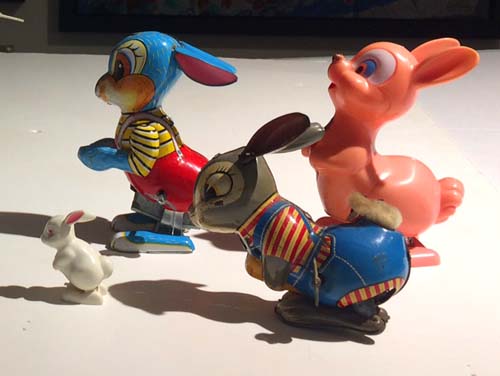
I've been collecting some windup rabbits for awhile, just because I
like them. Now it's time to put them to work. I imagined a
roadside vegetable stand with these rabbits approaching it for
some snacks. That led me to the vegetable everyone associates
with rabbits, the carrot!
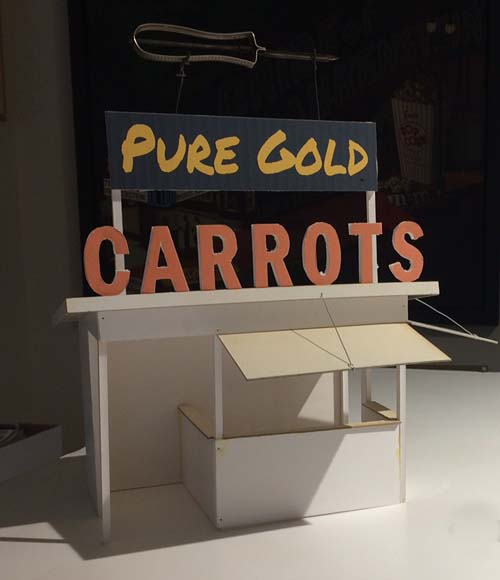
Rather than trying to find a roadside stand, I
built a replica in my studio with foam core and mat board.
Another object associated with a carrot is a 'potato peeler.'
I've mounted one up above the 'Pure Gold' markee. Why pure gold?

Because my painting will be called
"24 Carrots."
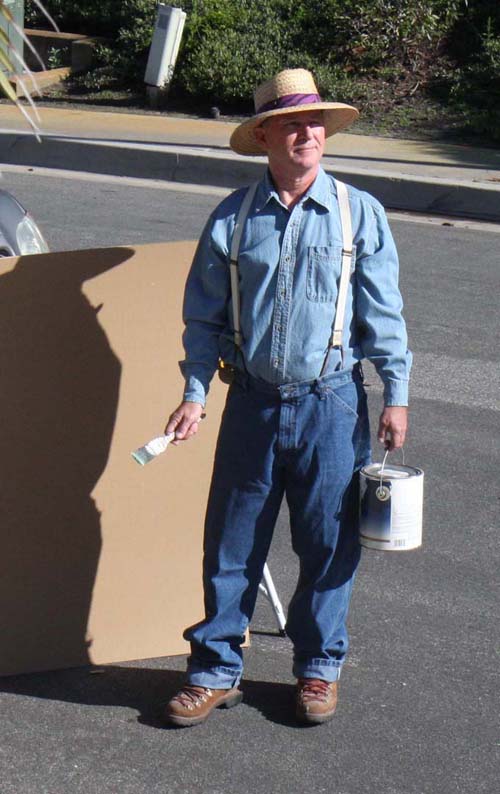
I enlisted the help of my friend, Andy, to
portray the carrot farmer. He's holding a paint brush and a can of
paint that he has used to spell out "NOW OPEN" on the front of
the stand. I might add that Andy went to some lengths to get
into the role of the carrot farmer. He's a very good golfer and
would never be caught in those baggy jeans on the golf course.
He patronized the local thrift store and coupled them with some
of his own 80's era suspenders to complete the look. Thanks for
going the distance, Andy!
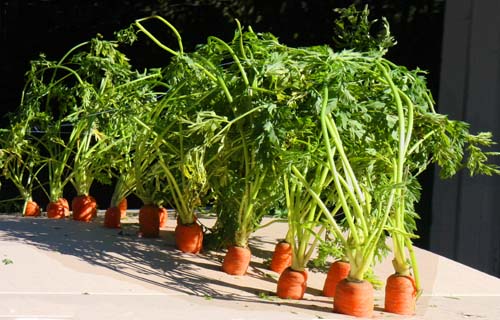
Today I purchased 5 bunches of carrots. In the old days,
all stores kept the tops on carrots until you got to the
checkstand and then they twisted them off if you didn't want
them. Finding carrots with tops on them was a little challenge,
and because they are not growing in the ground, the tops lose
their strenth and droop to the ground. I inserted the carrots
into holes, punched in a sheet of cardboard and then supported
the green tops by wrapping them in monofilament line and
attaching that line to a ladder nearby.
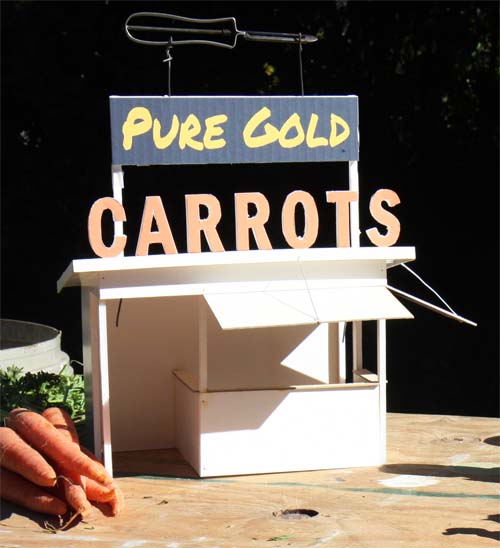
I photographed the roadside stand again, this time outside my
studio with direct sunlight, matching the photo I shot of
Andy in the street. Making sure that all objects in the painting
have the same light source, goes a long way in convincing the
viewer that everything exists together in that space and time.
The carrots on the side of the stand aren't big enough for my
design, so I'll draw them on the canvas as large as I need them.

I'm stretching my linen canvas on a pair of 24"x 30" stretcher
bars. I use a very fine portrait linen so that the surface of
the canvas doesn't detract or interfer with the detail that I
put in my images.
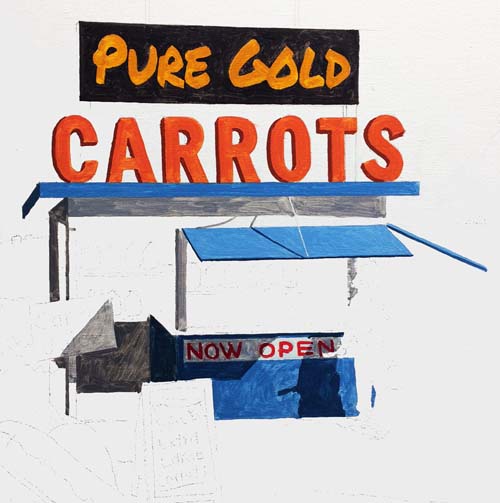
I've decided to begin with the carrot stand, applying thin coats
of color, defining the light and shadow areas.
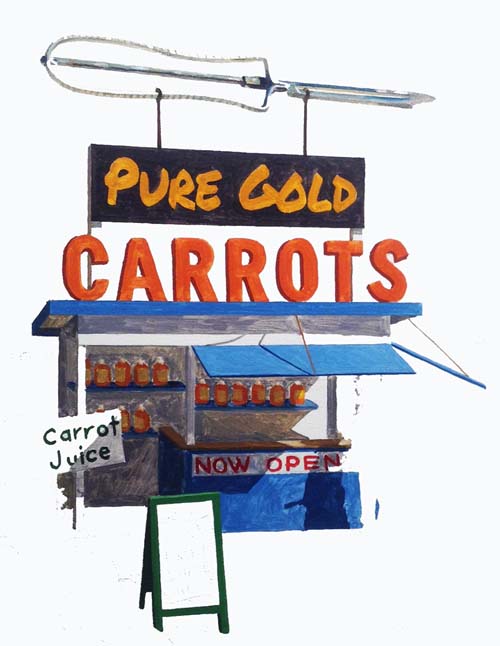
More detail is added to the stand. Next, I'll block in the sky
to help delineate the objects in the upper half of the painting.
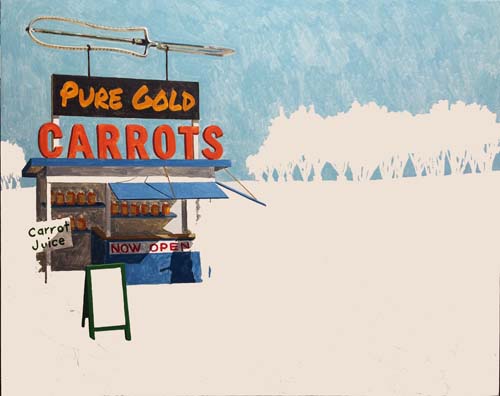
The sky is a simple mixture of thalo blue, cadmium yellow and
Permalba white. I thinned it with turpentine and used it to
outline the carrot tops and the top of the roadside stand.
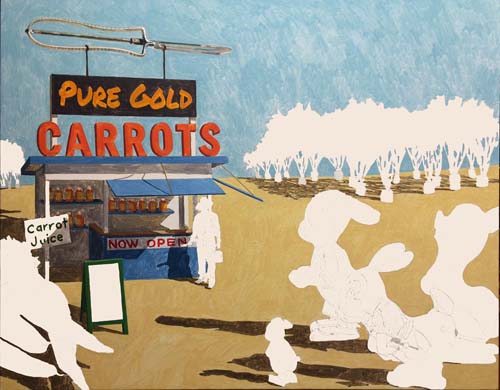
By blocking in the ground color (burnt sienna, cadmium
yellow,burnt umber, French ultramarine blue and white), the rest
of the painting is defined.
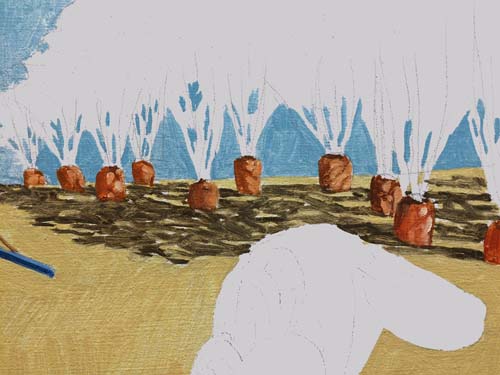
I can now start loosely rendering the carrots.

That includes the carrots in the foreground.
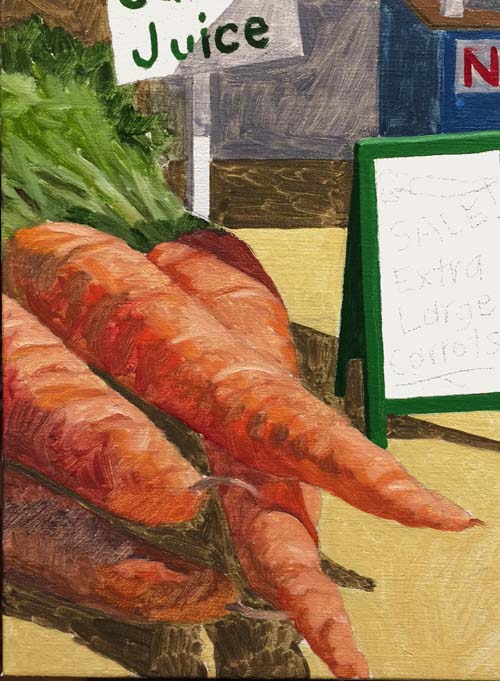
By adding the green tops with various shades of green, the
carrots take their place in the painting.

The distant carrots take on a tree like presence, casting their
shadows on the simply rendered earth.
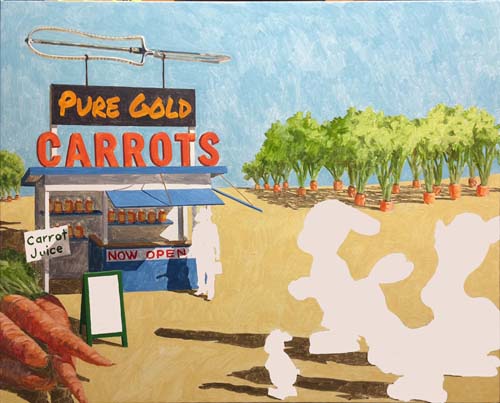
Here's a look at the entire canvas. Rendering the man and the
rabbits will be next.

I've begun to render the farmer, which will be an ongoing
project. Although I try to do a small portrait of Andy, when
painting a face the size of my thumbnail, the paint builds up
quickly and needs to dry before I can make some small
alterations.
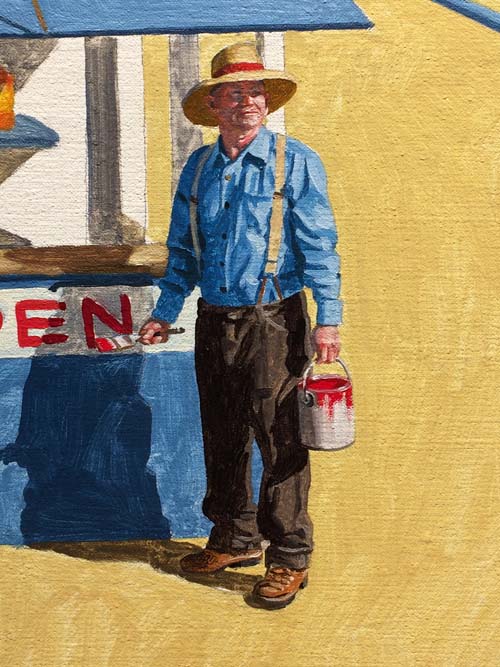
The farmer's clothing, paint brush and bucket of paint are all
detailed loosely onto the canvas.
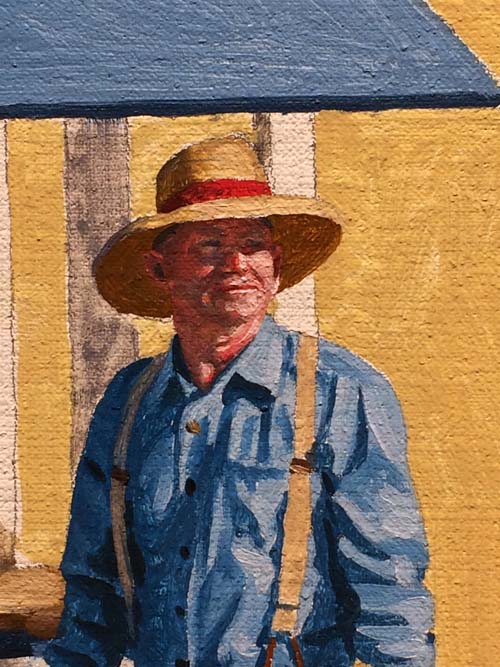
You might notice that I've already made some adjustments on
Andy's face since I first sketched it in with the first layer of
pigment.
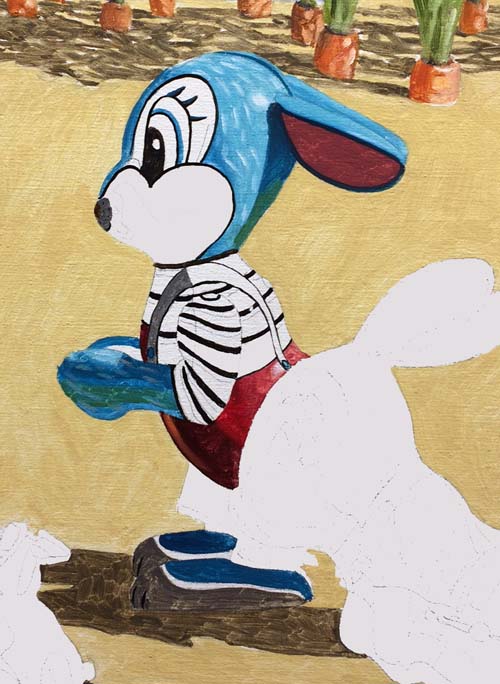
I'll work on one toy rabbit at a time, rendering the proper
lighting and shades of color.
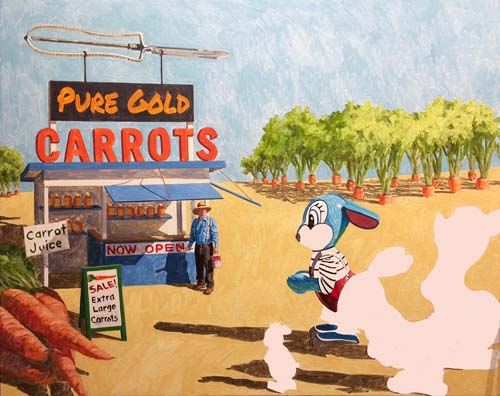
This photo shows the entire canvas at this point. There will be
many corrections in value and hue when I go on to the final
layer of paint.
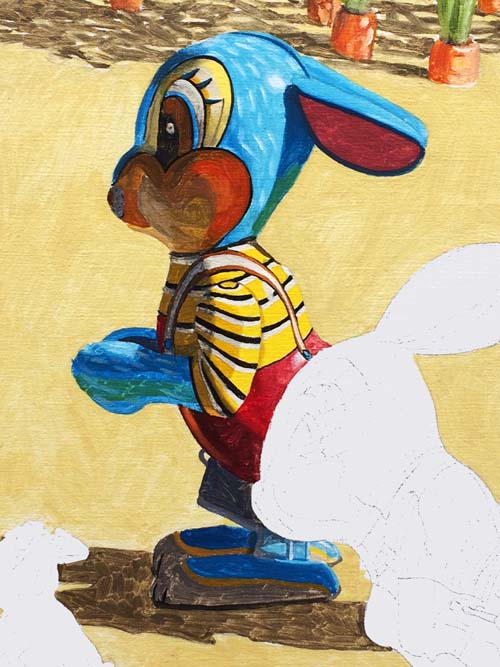
My main rabbit is all blocked in. I call him my main rabbit
because he's my favorite and there are not a lot of this model out there for sale. It
took me about a year to find this little guy.
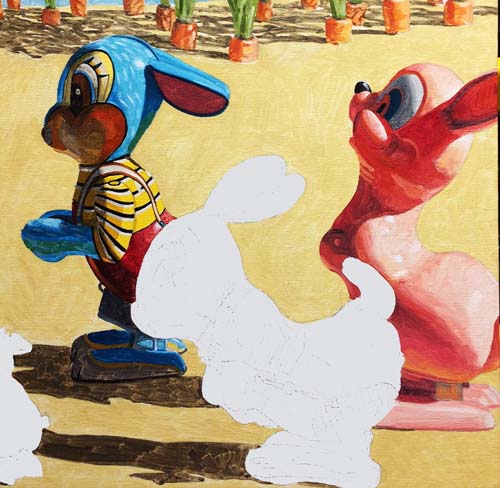
There are two plastic rabbits in this group of four. The pink
rabbit is the happiest bunny in the group. As vintage as he is,
every time I set him down, he tends to take off like he was
brand new!
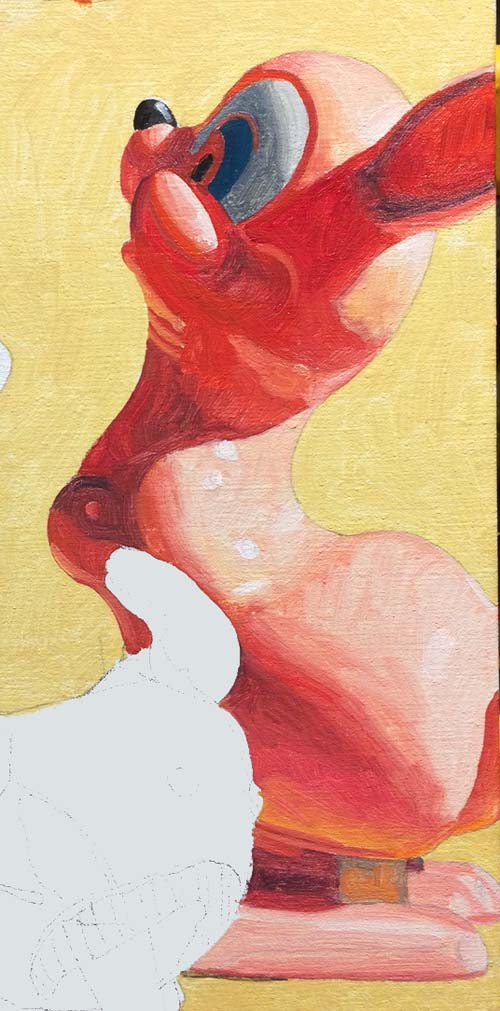
There is a lot of play of light on a hollow plastic object. When
the light passes through to the other side, it tends to make the
pink color turn much warmer.
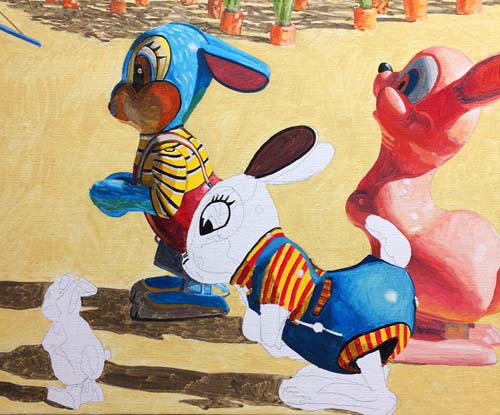
I've begun the third rabbit, painting his overalls first.
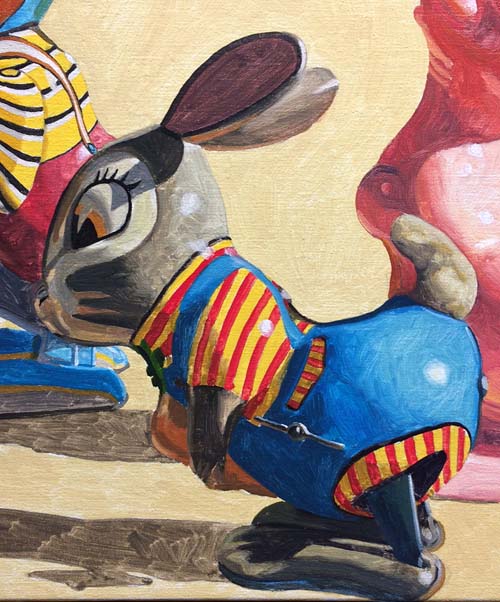
The grays of this rabbit's head is mixed with French ultramarine
blue, burnt umber and cadmium yellow. I added a little black for
the darkest areas of gray and a lot of Permalba white for the
lightest hues of gray. When I looked at all the rabbits up to
this point, the only wind-up key that was showing was on the
side of this rabbit.
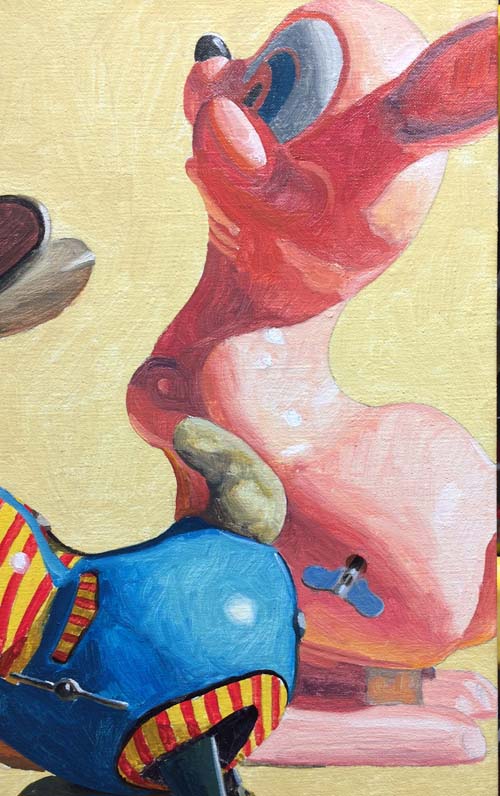
So, I decided to move the wind-up key to the rear of the pink
plastic bunny's body, reflecting the blue of the sky on the
surface of the key.
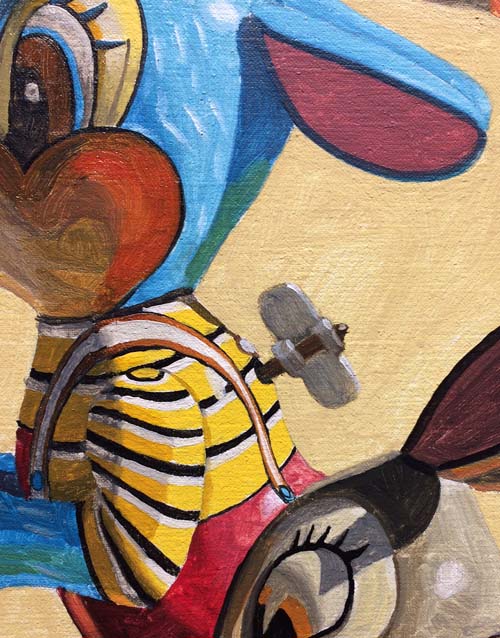
I moved onto my favorite rabbit and moved his key from his side
to his back. As I type this information, I realize that I didn't
put in the shadow cast by the key on his back. I will do that in
the second layer of paint.
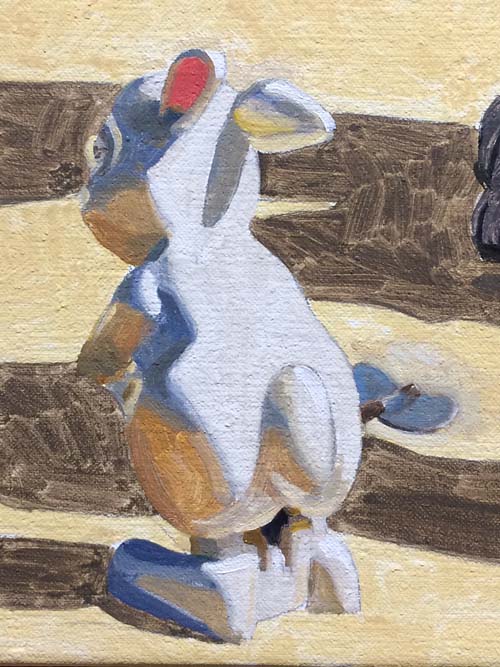
The little white plastic rabbit had a small plastic wind-up knob
that wasn't easily seen, so I installed a metal key.
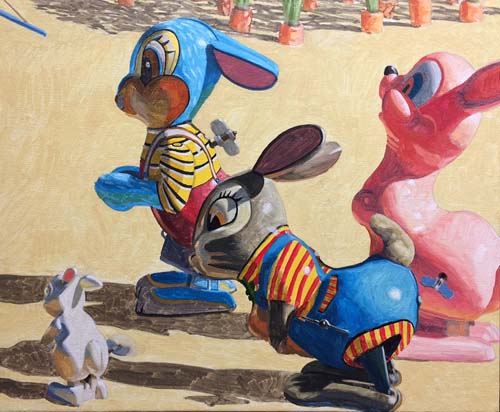
Here's a photo of the whole crew, anxiously awaiting to make
their food purchase.
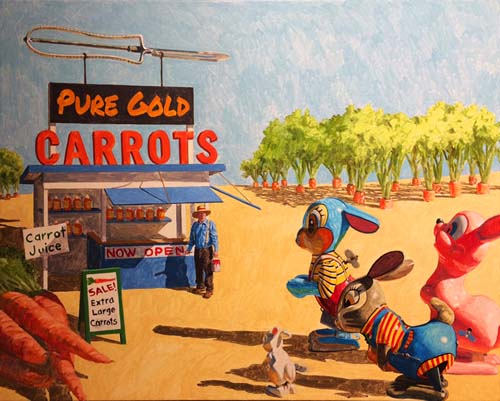
That brings us to to the halfway point in the painting. Every
bit of the linen canvas has had a thin wash of oil pigment
applied to it. Time to assess the image and decide on some
alterations and adjustments in hue and value.
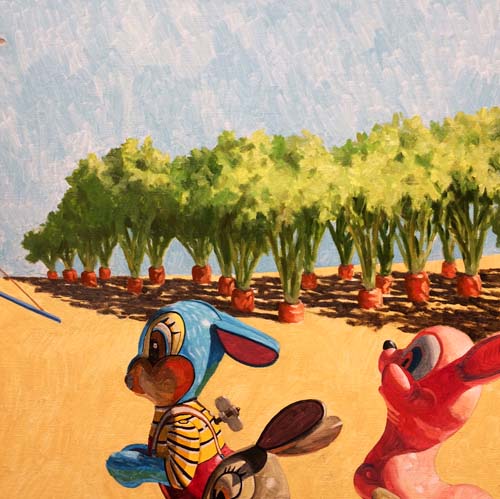
My first step in the final layer of paint was to stregthen in
both color and value, the carrot field. I've also added some
shadows to enhance the design.
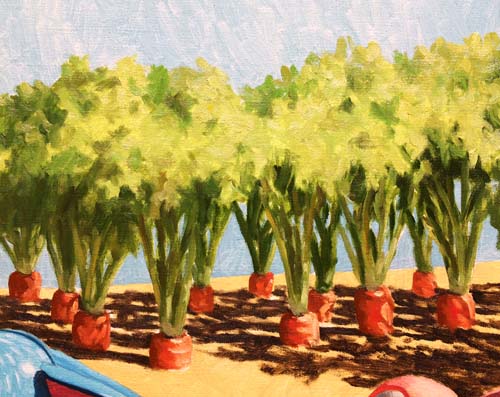
Here is a closer look at the carrots in the field.
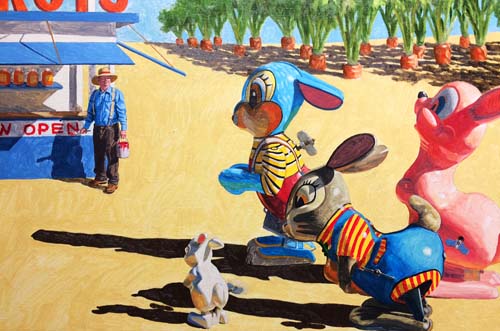
While I had some shadow color for the carrots mixed, I added
some additional burnt umber and French ultramarine blue. With
that darker mixture, I painted the cast shadows of the rabbit
gang.
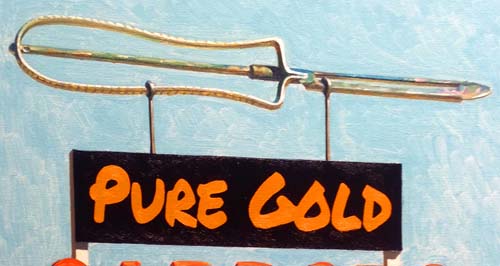
Moving on to the items that touch the sky, I've rendered the
peeler and the Pure Gold sign. The peeler is treated as a
reflective object, reflecting both the cool blues of the sky and
warm hues of the earth below. I could see some green hints in
certain areas of the metal and painted them also. The sign is
pretty straight forward, with the wording mixed with cadmium
yellow and burnt sienna and the dark area a mixture of French
ultramarine blue, burnt umber and ivory black.

As I decend down the carrot stand, I've finished the "CARROTS"
letters and also started on the blue and white of the building.
When the areas that touch the sky have dried, I'll put the final
layer of pigment on the sky.
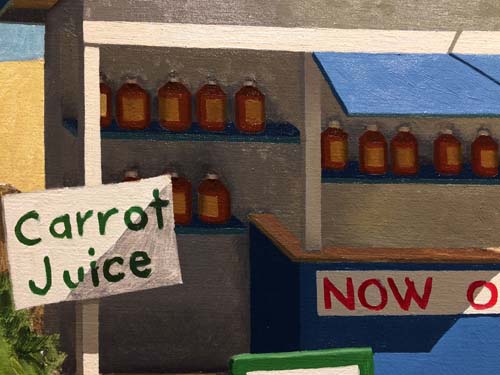
I've detailed the stand, painting all the bottles of carrot
juice on the shelves and all the shaded areas. Aside from the
'Carrot Juice' sign, this area is finished.
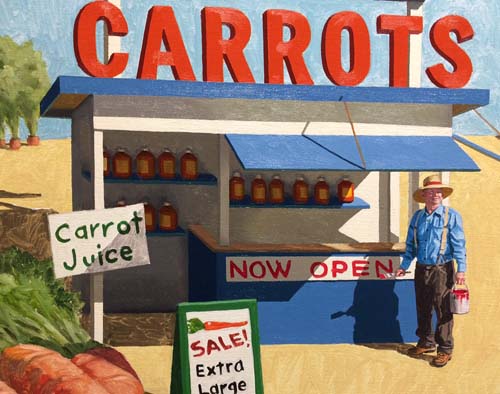
The farmer isn't finished, but the stand behind him is
completed.

With the stand out of the way, I'll wait a few days and then
tackle the sky.
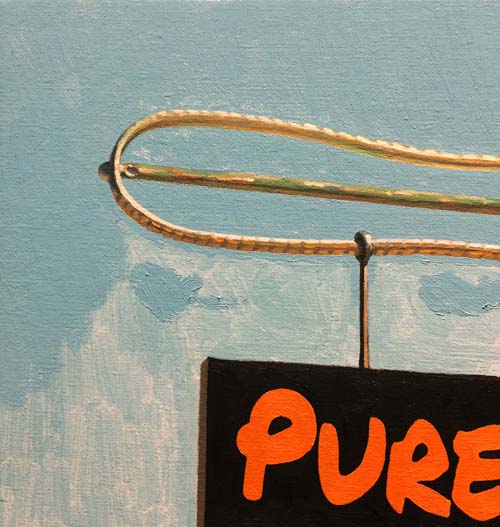
This photo shows just how much darker I am making the sky with
my second pass over the canvas.
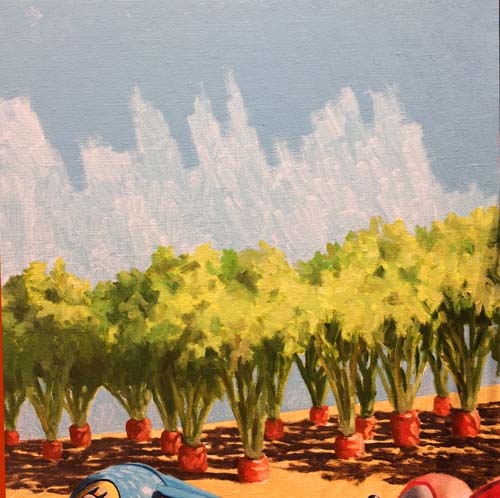
Here's another photo that shows the increase in value with the
final coat of paint on the sky.
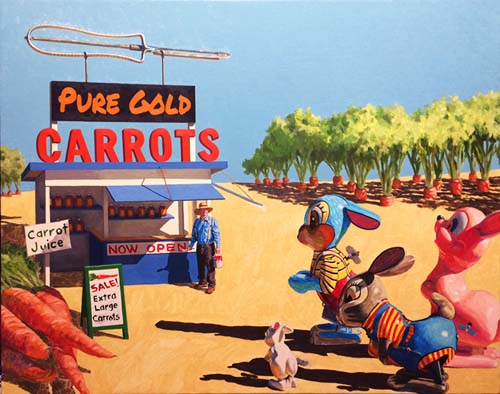
The simplicity of the flat blue sky color helps to outline the
carrot peeler and makes the stand pop off the canvas.
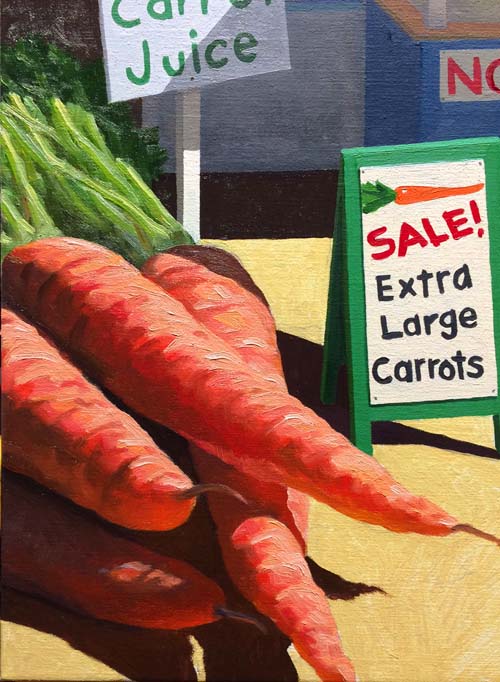
I've piled on the pigment to the four carrots in the foreground,
applying rich hues of orange in the shaded areas of the carrots
that reflect the warm light of the ground.
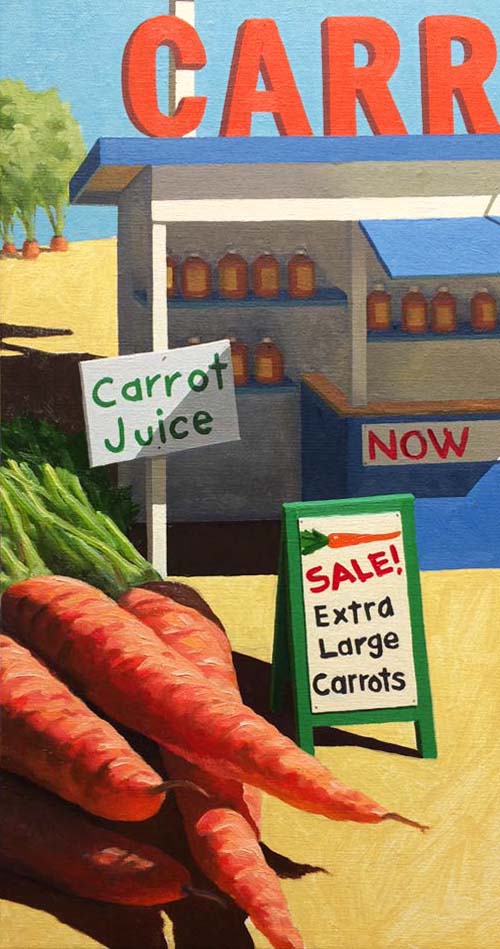
Along with the carrots, I've applied the final layer of oil to
the cast shadows of the 'SALE' sign, the interior ground shadow
of the stand and the shadow that the stand casts on the ground
behind the structure.

The tin toy rabbits require a lot of tedious detail work, mixing
many values of each hue to help render all the subtle nuances of
light and shadow areas. Here, I've completed just the head of
the main rabbit. He's a very cool looking hare!
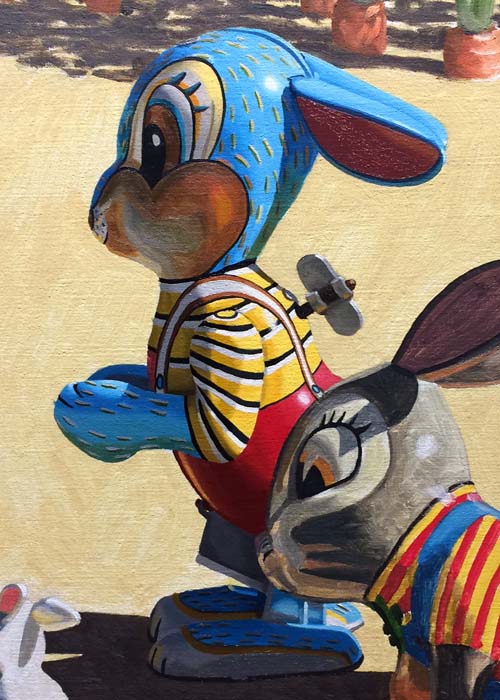
My favorite wind-up rabbit is finished! Now off to another one
of the 4.
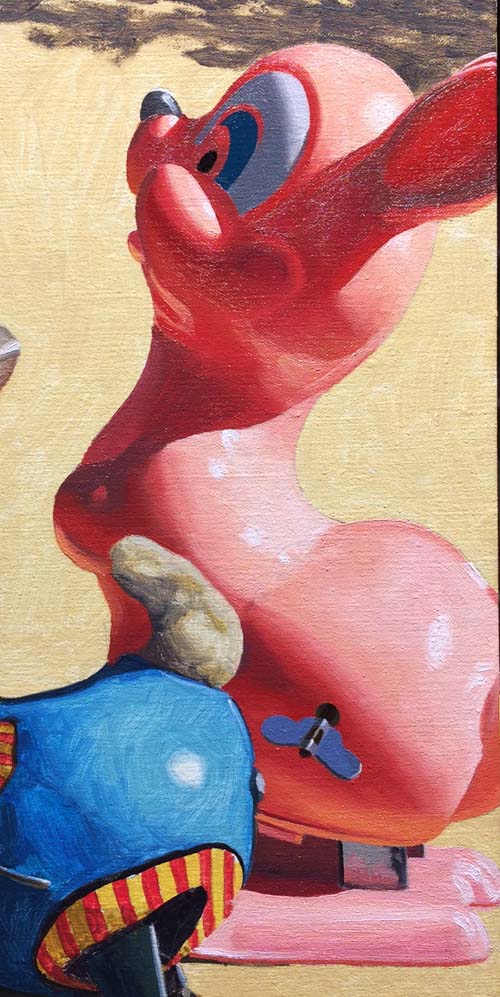
The pink plastic rabbit is finished. He's so happy, looking at
the carrot peeler!

The head of this foreground rabbit is finished, as well as his
yellow and red shirt.
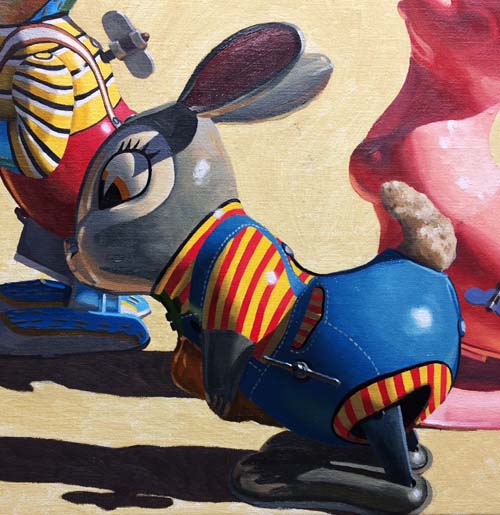
The foreground rabbit is finished. Notice the detailed stitching
on his overalls.
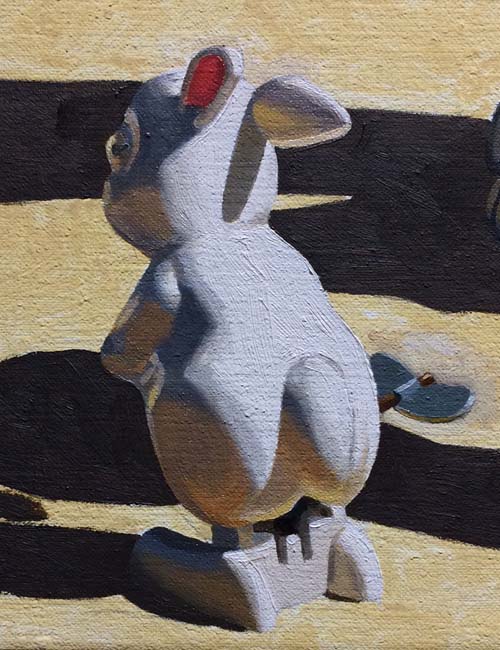
The small white rabbit is a study in values. Not much color
here, but enough reflective light in the shaded areas to
introduce some nice warms that bounce up from the ground.
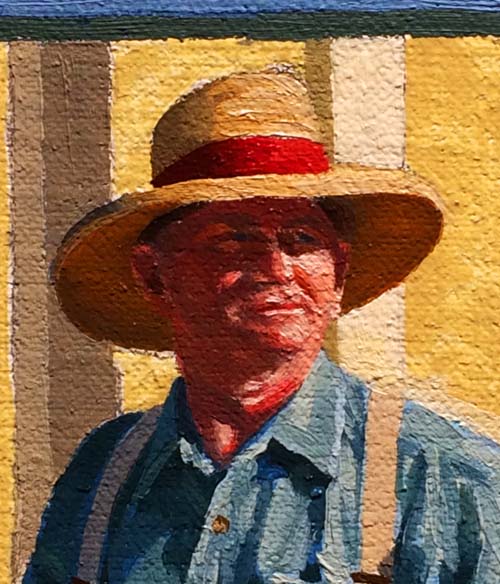
Just put the final touches on Andy, the farmer. Darkened and
increased the warmth in his skin tones and changed the color of
his shirt a bit for some added interest.
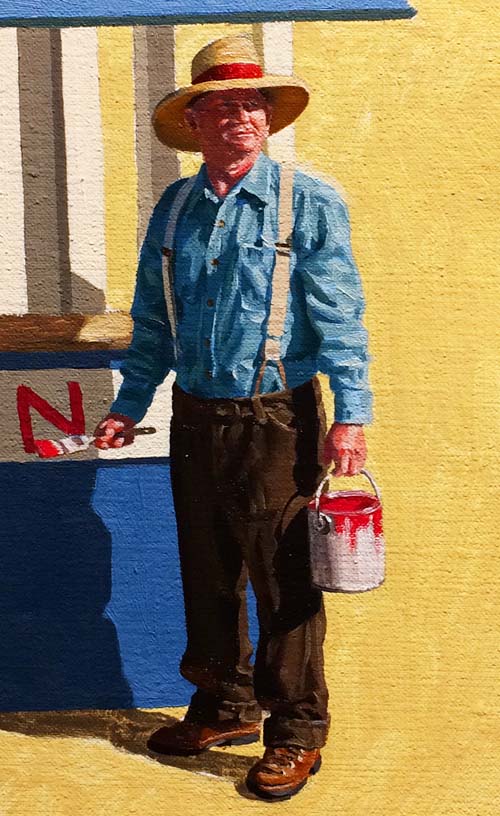
Here's a photo of Andy from top to bottom. He turned out great!
Just a few more adjustments to the roadside stand and I'll paint
the large yellow toned ground to bring "24 Carrots" to an end.
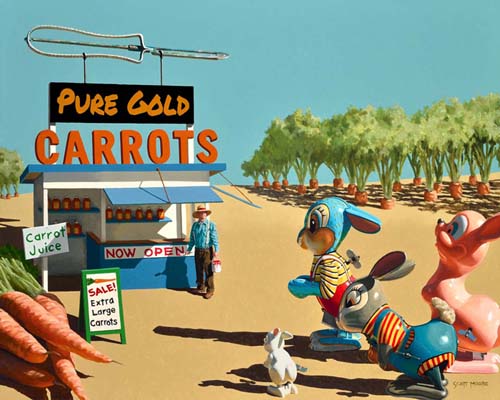
"24 CARROTS" is completed. If you
would like to visit this painting in person, you can see it at
the Hilbert Museum of California Art at
Chapman College. It was purchased by the museum for their
permanent collection.
|